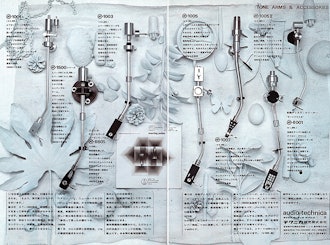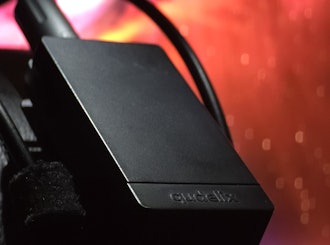Click to view our Accessibility Statement or contact us with accessibility-related questions














Showing 1 of 22 conversations about:

rastus
1391
Nov 1, 2018
bookmark_border
An actual 11.2 DSD studio recording from Blue Coast; “Recorded in DSD256 and mixed through analog console to DSD256”: https://bluecoastmusic.com/Meghan-andrews/fire-single#.W8aozKQpDYU
“This is a single song bundle including all (8) formats: DSD256, 128 & 64, 19224 WAV & FLAC, 9624 WAV & FLAC as well as CD Quality 4416 WAV.”

ElectronicVices
2937
Nov 2, 2018
bookmark_border
rastusAh shit... love me some tracks in multiple formats. Do you know if they were all encoded during the same mastering session on the same gear?

rastus
1391
Nov 2, 2018
bookmark_border
ElectronicVicesIt does not specifically say; but by stating recorded in DSD256; all others are thereby converted from. A fair test then of the formats; in studio conversion; to the extent your rig accepts. In a word, exquisite, the artist & recording.

ElectronicVices
2937
Nov 4, 2018
bookmark_border
rastusI only ask as I've got a couple of different test sets that were all encoded during the same mastering session in different formats and at different bit rates. I use them to see if my friends can tell a difference between CD quality and the various high res formats. Thanks for sharing!

rastus
1391
Nov 16, 2018
bookmark_border
ElectronicVicesWhy don't we get more higher quality recordings?...
Why don't more professional audio engineers record above CD quality?
Saturday, October 20, 2018 - 11:51 "This is a question that has perplexed many of us who record in high resolution audio. Sure, our focus is on DSD / one bit recording... but why are most audio engineers recording at 44.1 or 48? You think it would be easy to move to PCM 9624 or 192. Heaven forbid anyone should move to recording in DSD! It's not a simple answer. One problem to point out is our education system. Sadly, our audio schools don't teach students to record in higher resolution formats. Maybe if there was more demand and more spoken about it directed to mass consumers, we might see a change.... just as there was for headphone demand and vinyl surging. Generally, students and schools are on limited budgets. While cost of disc space is going down, multitrack recording still requires a lot of space and management. In recording at 44.1 sampling rate, a song can require 10-100x the space on a hard drive than the final 2 track mix. Add to that multiple takes and overdubs and that album starts to add up. Then there's the time to backup. We then need to consider managing the computing power which can cause issues with sound if not sufficient. While in school, students tend to be more focused on plugins rather than learning microphone techniques (which are also expensive). Most plugins work at 44.1 or 48K sampling rate. A new engineer is inclined to collect and purchase plugins that work for the lower sampling rates. Also to note.. many plugins are not made for higher sampling rates. When becoming a professional these new audio engineers are inclined to do what they're used to and bring in the lowere resolution plugins. Anyone recording and mixing in DSD knows the challenges we face. We've modified our behaviors to work in a format that pleases our ears. Try teaching DSD recording to a PCM engineer... even the best... and you'll find roadblocks and complaints of how hard it is to record in DSD. Those of us who learn to record in DSD do it for love of sound. :) Here's a new single at Blue Coast Music recorded live to DSD256. Meghan Andrews sings a classic.. "I'm on Fire". You'll receive 8 different formats to in the download. Try them out. You'll know why we choose DSD." https://bluecoastmusic.com/meghan-andrews/fire-single#.W8t3DflKiig
https://dsd-guide.com/why-dont-more-professional-audio-engineers-record-above-cd-quality#.W-8evuhKiUl
Saturday, October 20, 2018 - 11:51 "This is a question that has perplexed many of us who record in high resolution audio. Sure, our focus is on DSD / one bit recording... but why are most audio engineers recording at 44.1 or 48? You think it would be easy to move to PCM 9624 or 192. Heaven forbid anyone should move to recording in DSD! It's not a simple answer. One problem to point out is our education system. Sadly, our audio schools don't teach students to record in higher resolution formats. Maybe if there was more demand and more spoken about it directed to mass consumers, we might see a change.... just as there was for headphone demand and vinyl surging. Generally, students and schools are on limited budgets. While cost of disc space is going down, multitrack recording still requires a lot of space and management. In recording at 44.1 sampling rate, a song can require 10-100x the space on a hard drive than the final 2 track mix. Add to that multiple takes and overdubs and that album starts to add up. Then there's the time to backup. We then need to consider managing the computing power which can cause issues with sound if not sufficient. While in school, students tend to be more focused on plugins rather than learning microphone techniques (which are also expensive). Most plugins work at 44.1 or 48K sampling rate. A new engineer is inclined to collect and purchase plugins that work for the lower sampling rates. Also to note.. many plugins are not made for higher sampling rates. When becoming a professional these new audio engineers are inclined to do what they're used to and bring in the lowere resolution plugins. Anyone recording and mixing in DSD knows the challenges we face. We've modified our behaviors to work in a format that pleases our ears. Try teaching DSD recording to a PCM engineer... even the best... and you'll find roadblocks and complaints of how hard it is to record in DSD. Those of us who learn to record in DSD do it for love of sound. :) Here's a new single at Blue Coast Music recorded live to DSD256. Meghan Andrews sings a classic.. "I'm on Fire". You'll receive 8 different formats to in the download. Try them out. You'll know why we choose DSD." https://bluecoastmusic.com/meghan-andrews/fire-single#.W8t3DflKiig
https://dsd-guide.com/why-dont-more-professional-audio-engineers-record-above-cd-quality#.W-8evuhKiUl
Related Posts

storyboardtech
Finding your groove: getting into vinyl with Audio-Technica
I’d like to think that I could’ve been friends with the late Hideo Matsushita, founder of Japanese Hi-Fi powerhouse Audio-Technica. If I could, I’d travel back in time to 1960’s Tokyo, where a young Matsushita curated “vinyl listening sessions” at the Bridgestone Museum of Arts, exposing visitors to the sounds and possibilities of high end audio and the warmth of vinyl records. I imagine sitting with him in a mod coffee shop, listening to the stories of what he witnessed in those sessions, the conversations he had with visitors, and what ultimately motivated him to head back to his small apartment above a ramen restaurant and start an audio company of his own. In the histories I’ve read regarding AT’s humble beginnings, Matsushita’s motives seem clear. Produce high end audio at affordable prices, bringing audio excellence into spaces and to customers that simply didn’t have access to it before. His first two products, the AT-1 and AT-3 phono cartridges did exactly that, and...
Dec 6, 2023

MrChiSox
Big changes coming to my tiny little music room, I've recently purchased a new stack. Currently figuring out where to locate it all and ordering up the necessary cables, it won't be too long before I'm up and running. I am now the proud owner of a brand new stack. It's a European brand called Earmen. Amp, DAC, Streamer & Linear Power Supply. It won't be long!
https://www.youtube.com/watch?v=MB15yM4UptQ
Apr 23, 2024

dantso
do the inputs (rca, tos, bt, usb, etc) sum/mix or is that a selector switch in the front? might be nice if they just mix...
Apr 22, 2024
Trending Posts in Audiophile

SsButerbal
Ringing in PC38X's
I recently got this headset, and wow is it good. My only issue is when certain people talk on discord, I can hear a really high pitched ringing. I fiddled with a bunch of settings, computer audio and discord, and nothing seems to solve the issue. It is primarily if not all in my right ear only. Is there something wrong with my headset, or was that ringing always there I can just hear it cause the headset is THAT good? I haven't had any issues with any other application, though I have yet to test if I can hear the ringing on a different version of discord, say on my xbox instead of my pc. Only other issue I've had is occasional static, but I can't tell if it's from the headset or the show/game/etc.
Apr 24, 2024
itsamepe
Sennheiser PC37X randomly goes bad after disconnecting the cable ?
Greetings, Yesterday I was using my headset like normal with my macbook, just listening to music and on a call with people like usual, and the headset was perfectly fine. The stock wire that came with the headset is extremely long and yesterday it annoyed me very much that it kept getting tangled with itself, so I decided to see if the cable is replaceable. I pulled out the cable from the headset and saw the adapter, and looked online for a replacement. Upon plugging it back in, the audio sounded extremely muffled and washed out. Im not sure what I did wrong to make it mess up like that as I've always taken good care of it, ive had it for about 2 years and its always just been chilling on my desk, but anywho I thought the cable just went bad and ordered a replacement. The replacement came, and the issue is still persistant, so I am not sure what the issue is I've tried multiple different headsets and the issue is not with the port, and I also tried it with my windows laptop and...
Apr 23, 2024

MrChiSox
Big changes coming to my tiny little music room, I've recently purchased a new stack. Currently figuring out where to locate it all and ordering up the necessary cables, it won't be too long before I'm up and running. I am now the proud owner of a brand new stack. It's a European brand called Earmen. Amp, DAC, Streamer & Linear Power Supply. It won't be long!
https://www.youtube.com/watch?v=MB15yM4UptQ
Apr 23, 2024

Briankan
Recommendation for my next headphone set? I have Koss 95x
Hey all, What would you recommend I get next and why? I have Koss ESP-95x electrostatic massdrop headphones. These are my first and only audiophile set. I love them. I think my only real requirements is $500 or less for the headphones and that they have a little more low end. I don’t need thump but these are really light on lows…but the experience is still awesome. Also any recommendations on an amp? I only have my electrostatic thingy. I am using the Topping D50 DAC. thx!!
Apr 22, 2024

Simthaniel
Rigs
Modded headphones with qudelix at the core
When I received the Qudelix 5K, I had already modified a pair of Superlux HD-681 headphones. I previously soldered my own balanced connections to the drivers, providing multiple ways to connect and...
Apr 14, 2024

brothamike
A decent set of IEMs
I am in the midst of a 300 hour burn-in but, I will say I am enjoying how this set sounds so far. Before I received these which was btw late by a few weeks, I purchased a Sony/Kimber Kable MMCX...
Apr 12, 2024
merrick97
Should I exchange the PC38X for better headphones?
I bought the PC38X headphones FOR GAMING and they are great, but I have NO use for a Microphone since I don't do competitive gaming and I was wondering if there were better headphone options at a similar price without a headphone, where (presumably) more of the cost was put into making it sound better. I also find that my PC38X don't get quite as loud as I would like and I was wondering if a cheap amp like the iFi Go link would draw a little more volume out of my phones. https://www.amazon.com/dp/B0BN6MM822?psc=1&ref=ppx_yo2ov_dt_b_product_details I went with the PC38X since it was considered the best bang for buck headphones. I care most about using spatial apps like DOlby Atmos and DTS Headphone:X. Suggestions are welcome.
Apr 11, 2024





